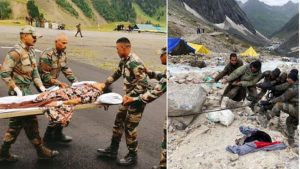 Srinagar: The death toll in the flash flood triggered by heavy rain near the Amarnath cave shrine rose to 16 on Saturday as the search operations continued without a break amid fears that many are still trapped under the debris.
Srinagar: The death toll in the flash flood triggered by heavy rain near the Amarnath cave shrine rose to 16 on Saturday as the search operations continued without a break amid fears that many are still trapped under the debris.
Officials said 15,000 stranded pilgrims were shifted to the lower base camp of Panjtarni and 25 injured people were rushed to hospitals after the flash flood and landslides rummaged through tents and community kitchens on Friday afternoon.
According to an Army official, mountain rescue teams and lookout patrols with high-tech equipment and sniffer dogs have been deployed for the search and rescue operation.
“Air rescue operations started Saturday morning and six pilgrims were evacuated by Army helicopters. The military medical teams are receiving patients and casualties at the Nilagrar helipad for onward evacuation,” an official said.
An Mi-17 chopper of the BSF’s air wing has been pressed into service. The Jammu and Kashmir administration has also deployed advanced light helicopters for rescue operations.
A Border Security Force (BSF) spokesperson in Delhi said, “Sixteen bodies have been shifted to Baltal.”
The ITBP has expanded its route opening and protection parties from the lower part of the holy cave up to Panjtarni, a spokesperson of the force said.
Additional Director General of the Jammu and Kashmir Police, Vijay Kumar, who holds charge of the Kashmir range, reached the holy cave shrine on Saturday morning to supervise the rescue operations being conducted by security forces and the National Disaster Response Force.
He said the rescuers were clearing the debris to look for survivors as the administration was cross-checking the data of pilgrims to get the exact number of casualties. Every pilgrim has been provided with a Radio Frequency Identification card this time because of terror threats.
Among those who escaped the tragedy was Telangana BJP MLA T Raja Singh. The legislator and his family members, who reached Amarnath by a helicopter, decided to ride ponies on their way back as the weather began deteriorating.
“We sensed that the weather suddenly changed for the worse. In that circumstance, the helicopter service would also be cancelled. So we decided to descend the hills riding ponies. I could see the rains on the hills and then several tents got swept away in the floods,” Raja Singh told reporters on Friday night.
The annual pilgrimage, which began on June 30, has been suspended following the tragedy and a decision on its resumption will be taken after rescue operations get over, a senior administration official said.
“Most of the pilgrims, who were stranded near the holy cave shrine area due to the flash flood, have been shifted to Panjtarni. The evacuation continued till 3.38 am. No pilgrim is left on the track. About 15,000 people have been safely shifted till now,” the Indo-Tibetan Border Police (ITBP) spokesperson said.
The BSF spokesperson said medical staff of the paramilitary force treated nine patients who were critically injured in the floods. “They have been shifted to the lower-altitude Neelgrath base camp.”
A team of BSF personnel has been deployed at the Neelgrath helipad to assist the pilgrims coming from the cave shrine. About 150 pilgrims stayed at the BSF camp set up in Panjtarni on Friday night and 15 patients have been airlifted to Baltal on Saturday morning, he said.
The injured were being treated at the Nilkant camp in Sonamarg. An integrated command centre has been set up under the charge of the divisional commissioner of Kashmir while helpline numbers have been established in Anantnag in South Kashmir, Srinagar and in Delhi for families of pilgrims to know about the wellbeing of their kin.
An Army official said an infantry battalion led by a colonel along with Quick Reaction Teams, an additional company from the Rashtriya Rifles Sector and a team from special forces had reached the shrine with specialised rescue equipment to undertake the operation.
“Through the night, the senior Army officers of the infantry battalion and Rashtriya Rifles oversaw and coordinated rescue operations. Medical resources at the cave and at Nilgrar were activated and additional resources deployed,” he said.
Nine surveillance detachments with hand-held thermal imagers, night-vision devices and other gadgets were deployed for the search operations, the official said
“Two advanced light helicopters were moved for casualty evacuation at the holy cave. However, owing to bad weather, night landing at the cave was unsuccessful. Two Through-Wall Radars and two search and rescue dog squads were also moved to the cave,” he added.
However, notwithstanding the flash floods and the deaths, the 11th batch of over 6,000 Amarnath pilgrims left Jammu city on Saturday for the twin base camps in Kashmir.
The 43-day Yatra began on June 30 from the twin routes — the traditional 48-km path from Nunwan in Pahalgam in south Kashmir’s Anantnag, and the 14-km shorter but steep Baltal route in Ganderbal district of central Kashmir.
The pilgrimage to the cave shrine is being held after a gap of three years. In 2019, the pilgrimage was cancelled midway ahead of the Centre abrogating Article 370 provisions of the Constitution. The pilgrimage did not take place in 2020 and 2021 due to the Covid pandemic
